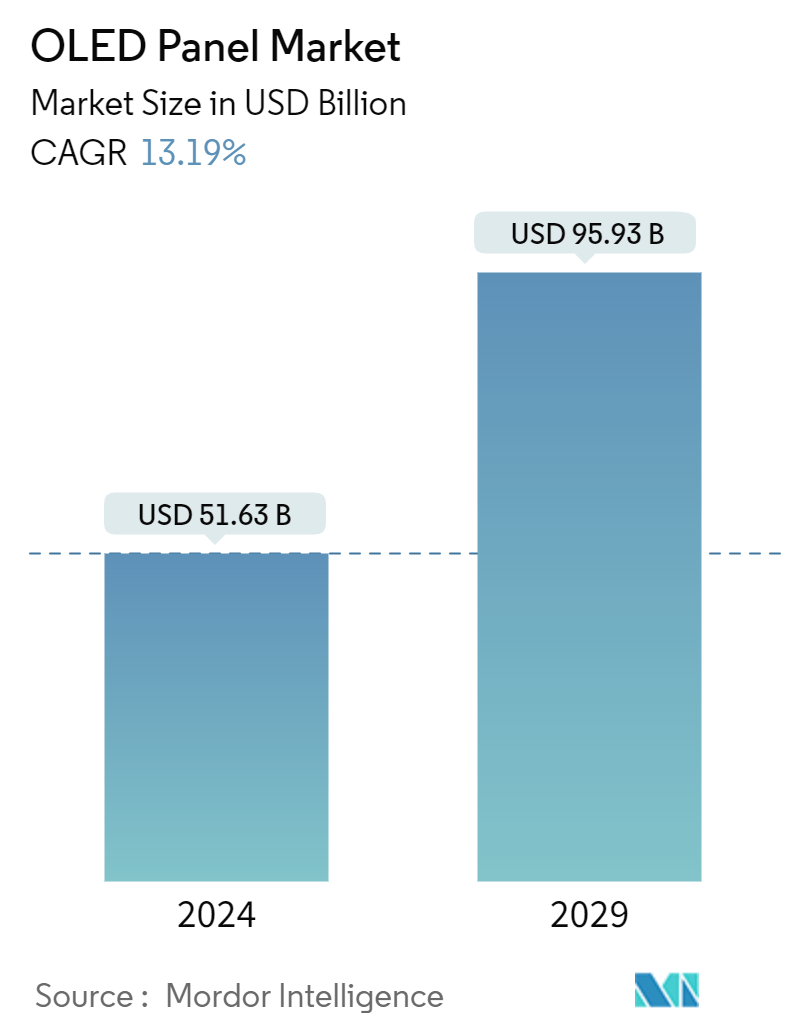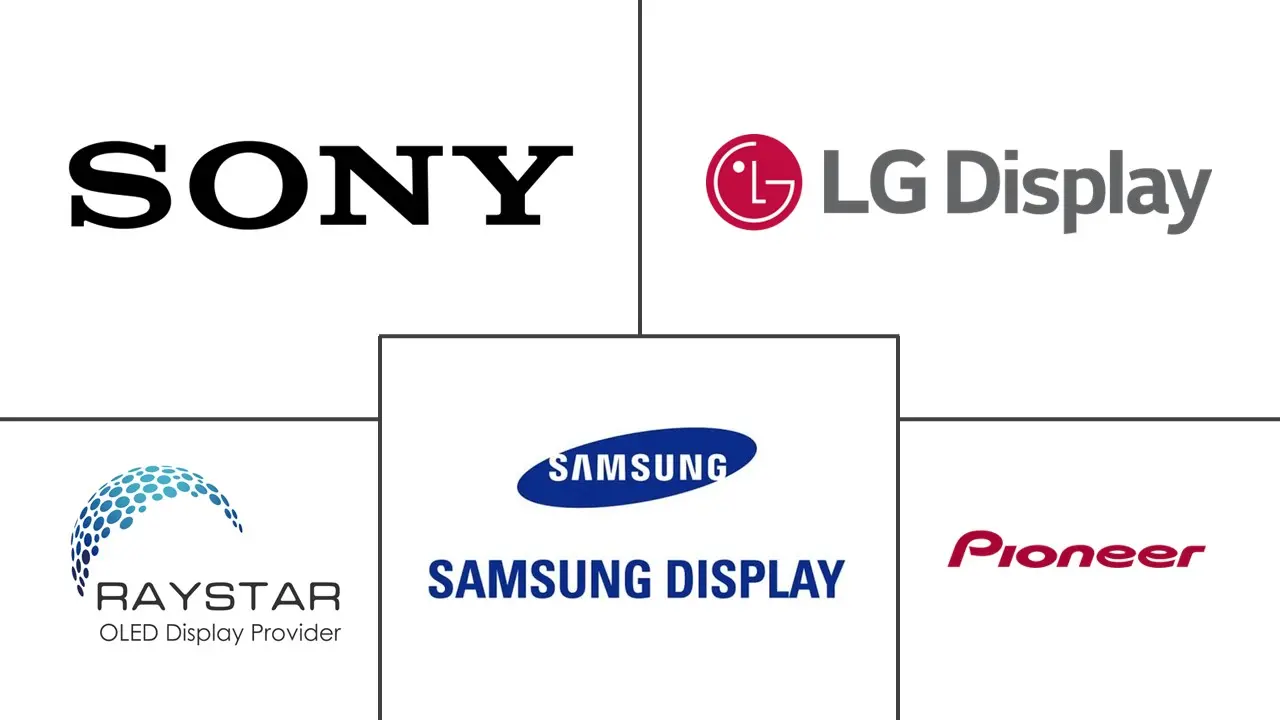Market Size of OLED Panel Industry

| Study Period | 2019 - 2029 |
| Market Size (2024) | USD 51.63 Billion |
| Market Size (2029) | USD 95.93 Billion |
| CAGR (2024 - 2029) | 13.19 % |
| Fastest Growing Market | Europe |
| Largest Market | Asia Pacific |
| Market Concentration | Low |
Major Players
*Disclaimer: Major Players sorted in no particular order |
OLED Panel Market Analysis
The OLED Panel Market size is estimated at USD 51.63 billion in 2024, and is expected to reach USD 95.93 billion by 2029, growing at a CAGR of 13.19% during the forecast period (2024-2029).
OLED is a significant display technology trend, with larger screen sizes, improved 8K (7680 x 4320 pixels) resolution, and relatively new form factors. For quite some time, companies like Samsung and LG have experimented with flexible OLED displays. Samsung, in particular, uses curved flexible OLED panels for all of its flagship devices now.
- OLEDs make it possible for emissive displays, where each pixel is independently controlled and generates its light (unlike LCDs, which get their light from a backlighting unit). OLED displays provide excellent visual quality, including vivid colors, quick motion, and, most significantly, a high contrast ratio. Most notably, "real" blacks (LCDs can't produce due to the illumination). Additionally, the straightforward OLED architecture makes it very simple to manufacture flexible and transparent panels.
- Due to multiple advantages with viewing angles and black levels, OLED Televisions are surging in demand in several regions. According to the ICDM, contrast modulation in qualifying a TV resolution is more critical than pure pixel count, and OLED TV displays cater to this demand.
- Based on market diffusion models, flexible OLEDs are anticipated to observe a high market penetration in the foreseen period. With the maturity of smartphones in many significant markets, such as China, smartphone manufacturers are developing new, foldable phone models that incorporate flexible OLEDs and further have a massive potential for growth over the next few years.
- Mass production enables companies to reach economies of scale, thereby benefiting the device manufacturers by reducing the overall price of the device. Only a few TV manufacturers currently use OLEDs, as the technology is considered too expensive for the mid-range market. Many fitness bands and simple smartwatch devices adopt PMOLED displays.
- For instance, Fitbit's Charge band uses a small monochrome (white) PMOLED display. The thickness, flexibility, and appearance of OLEDs show make it a promising technology for wearable applications over LCDs. Further, based on simple deterministic extrapolation, the demand for quantum dots-based OLED display panels is anticipated to surge exponentially in the forecast period.
OLED Panel Industry Segmentation
The term "OLED" refers to an Organic Light-Emitting Diode, a technology that uses LEDs and emits light made of organic molecules instead of conventional means. The most incredible display panels in the world are said to be made with these organic LEDs. OLED displays are created by sandwiching several organic thin sheets between two conductors. An intense light is produced when an electrical current is supplied. A straightforward layout that has several advantages over other display technologies.
The OLED Panel Market is segmented by type (flexible, rigid, and transparent), by display address scheme (PMOLED displays, AMOLED displays), by size (small-sized OLED panels, medium-sized OLED panels, and large-sized OLED panels), by products (mobile and tablet, television, automotive, wearable), and by geography (North America [United States, Canada], Europe [United Kingdom, Germany, Italy, France, Rest of Europe], Asia Pacific [China, Japan, South Korea, India, Rest of Asia Pacific], Latin America [Brazil, Mexico, Rest of Latin America], Middle East and Africa). The market sizes and forecasts are provided in terms of value in USD for all the above segments.
| By Type | |
| Flexible | |
| Rigid | |
| Transparent |
| By Display Address Scheme | |
| PMOLED Display | |
| AMOLED Display |
| By Size | |
| Small-sized OLED Panel | |
| Medium-sized OLED Panel | |
| Large-sized OLED Panel |
| By Product | |
| Mobile and Tablet | |
| Television | |
| Automotive | |
| Wearable | |
| Other Products (Lighting Products, Healthcare, and Home Appliances) |
| By Geography*** | ||||||
| ||||||
| ||||||
| ||||||
| Australia and New Zealand | ||||||
| ||||||
| Middle East and Africa |
OLED Panel Market Size Summary
The OLED panel market is experiencing significant growth, driven by advancements in display technology and increasing demand for high-quality visual experiences. OLED, or organic light-emitting diode, technology is gaining traction due to its ability to produce vibrant colors, quick motion response, and high contrast ratios, including true blacks. This technology is particularly popular in televisions and smartphones, where it offers superior viewing angles and black levels compared to traditional LCDs. The market is characterized by the development of flexible and transparent panels, which are being integrated into various devices, from smartphones to wearable technology. Companies like Samsung and LG are at the forefront, experimenting with curved and flexible OLED displays, while also investing in new form factors and resolutions, such as 8K. The simplicity of OLED architecture also facilitates mass production, which helps in reducing costs and making the technology more accessible.
The Asia-Pacific region is a dominant force in the OLED panel market, with major players like LG and Samsung having significant manufacturing presence there. The region benefits from a robust consumer electronics market and substantial investments in OLED technology, particularly in China, which is rapidly increasing its manufacturing capacity. The competitive landscape is intense, with numerous players vying for market share and investing in alternative technologies. Innovations such as Samsung's Rollable Flex and Sony's BRAVIA XR TV lineup highlight the ongoing advancements in OLED technology. Despite challenges like rising manufacturing costs due to inflation, the market is poised for continued expansion, supported by growing consumer demand for high-resolution displays and the increasing adoption of OLED panels in various applications.
OLED Panel Market Size - Table of Contents
-
1. MARKET INSIGHTS
-
1.1 Market Overview
-
1.2 Industry Attractiveness - Porter's Five Forces Analysis
-
1.2.1 Bargaining Power of Suppliers
-
1.2.2 Bargaining Power of Buyers
-
1.2.3 Threat of New Entrants
-
1.2.4 Threat of Substitutes
-
1.2.5 Intensity of Competitive Rivalry
-
-
1.3 Industry Value Chain Analysis
-
1.4 Assessment of Impact of COVID-19 on the Market
-
-
2. MARKET SEGMENTATION
-
2.1 By Type
-
2.1.1 Flexible
-
2.1.2 Rigid
-
2.1.3 Transparent
-
-
2.2 By Display Address Scheme
-
2.2.1 PMOLED Display
-
2.2.2 AMOLED Display
-
-
2.3 By Size
-
2.3.1 Small-sized OLED Panel
-
2.3.2 Medium-sized OLED Panel
-
2.3.3 Large-sized OLED Panel
-
-
2.4 By Product
-
2.4.1 Mobile and Tablet
-
2.4.2 Television
-
2.4.3 Automotive
-
2.4.4 Wearable
-
2.4.5 Other Products (Lighting Products, Healthcare, and Home Appliances)
-
-
2.5 By Geography***
-
2.5.1 North America
-
2.5.1.1 United States
-
2.5.1.2 Canada
-
-
2.5.2 Europe
-
2.5.2.1 United Kingdom
-
2.5.2.2 Germany
-
2.5.2.3 Italy
-
2.5.2.4 France
-
-
2.5.3 Asia
-
2.5.3.1 China
-
2.5.3.2 India
-
2.5.3.3 Japan
-
2.5.3.4 South Korea
-
2.5.3.5
-
-
2.5.4 Australia and New Zealand
-
2.5.5 Latin America
-
2.5.5.1 Brazil
-
2.5.5.2 Mexico
-
-
2.5.6 Middle East and Africa
-
-
OLED Panel Market Size FAQs
How big is the OLED Panel Market?
The OLED Panel Market size is expected to reach USD 51.63 billion in 2024 and grow at a CAGR of 13.19% to reach USD 95.93 billion by 2029.
What is the current OLED Panel Market size?
In 2024, the OLED Panel Market size is expected to reach USD 51.63 billion.

